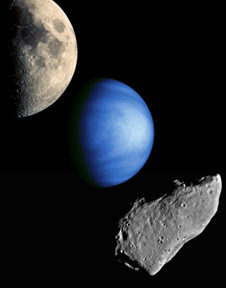Each such proposal will receive funding of 3.3 million dollars for the purpose of feasibility study. The selected project will be announced in 2011 and launched in 2018

NASA is in the company of three bodies in the solar system as candidates for the agency's next scientific mission. The final project to be chosen in mid-2011 may allow a better understanding of the creation of the Earth and possibly also of the origin of life on our planet.
NASA will select the mission that will be fully developed after a thorough study of the concepts and their examination. The studies will begin during 2010, the chosen mission must be ready for launch no later than December 30, 2018. The cost of the mission, not including the launch vehicle, will be limited to 650 million dollars.
"These projects inspire and excite young scientists, engineers and the general public," said Ed Weiler, NASA's assistant administrator for the Science Mission Directorate at NASA Headquarters in Washington. "These three proposals provide the highest scientific value out of eight submitted to NASA this year." Any such proposal will receive an initial budget of $3.3 million in 2010 with the goal of conducting a concept study for a year, which will focus on feasibility, costs, and managerial and technical issues. The requirement also includes educational programs and a small business partnership program.
The tasks are:
- SAGE – Investigating the geochemistry of the atmosphere and soil, this mission to Venus will involve releasing a small spacecraft to penetrate the atmosphere of Venus. During the way down, the instruments will make intensive measurements of the composition of the atmosphere and collect meteorological data. The spacecraft will land on the surface of Venus where it will use a scraping tool to uncover an ancient region that is not exposed to the atmosphere and examine its composition and mineralogy. Scientists hope to understand the origin of the planet Venus and why it is so different from Earth. Larry Esposito of the University of Colorado at Boulder is the principal investigator.
- Osiris-Rex – an acronym for Origins Spectral Interpretation Resource Identification Security Regolith Explorer spacecraft is a mission that will encounter a primitive asteroid and attack it. After intensive measurements, instruments will collect about 60 grams of material from the surface of the asteroid and return them to Earth. The resulting sample could help scientists better understand and answer age-old questions about the formation of the solar system and the origin of the complexities necessary for life. The project is led by Michael Drake of the University of Arizona in Tucson.
- MoonRise - a mission to recover samples from the Itkin crater at the south pole of the moon, which will include landing in the wide basin near the south pole and returning about a kilogram of lunar soil for research. This area is considered to be a place where there are many rocks dug out of the lunar crust. The samples will provide new insight into the early history of the Earth-Moon system. The project is led by scientist Bradley Jolliff of Washington University in St. Louis.
The proposals were submitted to NASA on July 31, 2009, in response to a call issued by the New Frontiers program. New Frontiers seeks to explore the Solar System in medium-sized missions that will deliver high-quality, focused science designed to expand our understanding of the Solar System.
The mission that will be chosen will be the third mission in the New Horizons project. The first was New Horizons which was launched in 2006 and which will pass through the Pluto/Charon system in 2015, after which it will focus on the study of the Kuiper belt. The second mission is Juno, which is planned to circle Jupiter from pole to pole for the first time and conduct an in-depth study of the atmosphere and interior of the giant planet. The spacecraft is scheduled for launch in August 2011.

5 תגובות
A mission to Venus/Moon will enrich knowledge but not advance humanity.
Asteroid exploration may be because it has many applications of real utility.
For the devil's advocate - the 3.3 million dollars is just to present the project, the project he chooses will receive funding of 650 million dollars.
3.3 million dollars? Sounds... a little.
They have so much there that even if they give 3.3 to each of the three (or the 20 or whatever they were in the early stage) they probably won't feel it. I don't understand what they are fussing about so much and spending 3.3 poor millions.
Wow!! It is so important to discover new resources for our technological development. Imagine what interesting materials we will find, and what it will do to our chemistry, biology and finally our physics. Amazing!!
These are rather odd projects compared to some of the important projects in the field of astronomy that we will hear about in the coming years: the New Horizon project to study the dwarf planet Pluto, the Kepler space telescope that has been going crazy for the past year, which is supposed to discover hundreds of new planets outside the solar system (and for the first time also planets the size of a jug "a), Space Interferometry Mission which is a telescope that has not yet been launched and is supposed to discover at least 2000 new planets, only that this time the focus will be mainly on planets the size of KDA and also located in the "safe zone" around the sun.
And again, all of these are intended to bear fruit in the coming decade, which is why I really don't understand why there is any enthusiasm at all at NASA to invest in projects that will innovate very little, such as another spacecraft to destinations we have visited in the past.